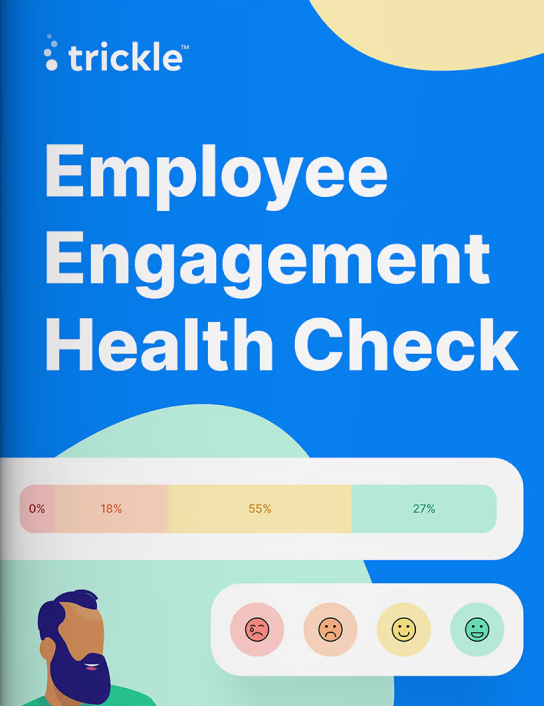How well does your company engage its employees?
Take your health check and find out.


After months in lockdown 3.0, as it has been dubbed, on April 12th the UK Prime Minister Boris Johnson unveiled his much anticipated roadmap out of lockdown e.g. the reopening of non-essential retail and outdoor hospitality venues.
If things go smoothly and without a major spike in infections, this could be a signal that the UK is finally turning a corner and moving towards recovery.
According to the Government’s roadmap, which is outlined in step three, no earlier than May 17th, most businesses, all except for ones in most high risk sectors, will reopen.
Many of us are right now rejoicing at being reunited with friends and family, having greater freedom of travel, or just having the opportunity to dine out or visit a beer garden.
And while there much to be happy about, this reopening period is also likely to be stirring up other more negative emotions such as anxiety, stress and concerns over the return to work and what that entails.
While some employees are keen to get back to the office, there is a significant number who are feeling anxious about their physical safety or how a return to the traditional style of working will impact their ‘new normal’.
Fear of the Office, or FOTO as it is known, is a real concern for many employees and one that employers need to start considering how they will address.
The concerns people are having are not all the same, while some are concerned about their risk of exposure to the virus, others are worried about the impact a return to onsite work will have on their life structure.
Although the UK has rapidly rolled out the vaccine, with nearly 50 million people in the UK having had at least one jab, we haven’t officially reached herd immunity status. For those who are unvaccinated there is still a real risk of infection and illness.
According to a survey of over 1,000 UK staff, 64% don’t want to return to office until colleagues are vaccinated, with social distancing being their chief safety concern.
Employees have been working from home now for over a year, and many have grown accustomed to this way of working and find it preferable for a number of reasons, such as;
Others may be worried about how a change to their work routine will impact their mental health or productivity, and fear that their wellbeing may be derailed.
A recent survey found that 41% of UK employees said they would be likely to resign if they were forced to return to the office against their will.
This figure suggests that employers should take to heart the varied experiences and perspectives of their employees when developing a return to work strategy.

– Tony Dungy, professional athlete and former head NFL coach.
Here are three things you should consider doing to best support your workforce and to alleviate or accommodate their anxieties as you navigate the reopening of your offices.
No matter what you may personally think of your employees’ concerns, for example that “they’re just overreacting” or “this is nonsense”, remember that for them their fear is genuine.
Rubbishing their concerns or ignoring them could irrevocably damage your relationship with your workforce and cause a sudden spike in employee dissatisfaction and possibly an exodus of your top talent.
Instead, business leaders should adopt an empathetic approach and try to understand the situation from the perspective of their employees.
Actively listen to and respond to employee concerns with understanding and emotional intelligence.
It’s imperative that organisations act with sensitivity and try where possible to accommodate their employees’ wishes.
Uncertain change can often be scary for people, particularly when it comes to their job. Including employees in this change planning process can give them a greater sense of control over this transition period, and thereby lessen their anxieties.
If possible, you should actively avoid making your employees feel they’re being forced into a work environment or style of working that will impact them negatively or put them in a potentially dangerous situation.
If employees feel they are being treated unfairly or that their concerns are not being properly addressed they are likely to start looking for other opportunities or disengage from their role.
Either way, in a highly charged situation like this, your workforce and organisation will be worse off for taking a top-down undemocratic approach.
If you provide your employees with a voice and platform to raise their concerns and share ideas, they can be part of finding the right solutions that balance their wishes with good business outcomes.
Radio silence is likely to stoke anxieties and fuel speculation over what’s going on within the organisation. In lieu of facts, people will start to jump to the worst possible conclusions, particularly during a period of stress or uncertainty.
That’s why now is the time employers should be considering a communication strategy to ensure that people are informed of upcoming changes and understand clearly the reasoning behind those decisions.
Organisations need to ensure that this information is highly visible, easily accessible, accurate, and that there is a means for employees to reach out for further clarification or guidance if needed.
Employers should consider how they will quickly disseminate this information across the entire organisation in an interactive way so that employees are able to feedback their sentiments in real-time.
This approach will enable employers to continually gauge their workforce’s reaction to changes as they happen and quickly highlight potential pain points that employers should address.
As we have seen with the previous lockdowns, things can change on a dime, so your approach and delivery method needs to be both dynamic and agile.
This is an opportune moment for organisations to reconsider their style of working and think about how they want to shape the future of the organisation at all levels.
The pandemic has been a catalyst for change in terms of workplace priorities and how we approach employee wellbeing and engagement.
It has proven that new ways of working, such as flexible and remote working, are in fact viable and beneficial for business.
It has also highlighted the importance of giving employees the opportunity to have a say in how they work and the need for employers to listen more to what their people are saying.
Employees across most industries have now had a taste of flexible working, and while some may not want to become fully remote, there is a new demand for a hybrid model of working.
How organisations choose to go forward in this moment and how they treat their employees, will have a lasting impact on its business resilience, brand reputation, and ability to retain and attract fresh talent.
Trickle lets employers have a daily finger on the pulse of their organisation by giving them a deeper and more dynamic understanding of how their workforce is feeling and doing in real-time.
Trickle provides organisations with honest, unbiased and timely feedback which helps leaders to initiate evidence-based interventions and focus attention where it is most needed.
Trickle is designed to give employees the confidence and means to voice what’s really on their mind, raise concerns, offer suggestions, or ask for support in a way that is comfortable to them.
Trickle breaks down silos and removes traditional barriers to communication by facilitating feedback from across your entire organisation to easily flow from the ground-level up, meaning no voices are left-out or missed.
The open, inclusive and transparent nature of Trickle enables collaboration at all levels to reach the right solutions for everyone.
Trickle’s Shout About feature is a quick and easy way for employers to raise awareness of changes, new policies or to direct employees towards further guidance.
This tool can also be used to highlight and praise particular teams, departments or individuals for outstanding work.
Using Trickle’s MoodSense feature, leaders can continually gauge, track and gain a better understanding of their employees’ sentiments about anything related to the organisation.
Leaders can use MoodSense to regularly ask employees to rate their opinion by casting a vote on any aspect of the organisation.
So, for example, a MoodSense could ask employees “How safe do you feel returning to the office” or “How happy do you feel working from home?”.
If employees cast a vote indicating they are unhappy they are then offered the option to raise Trickle, either publicly or anonymously, to voice their concerns or suggest a better way to move forward.
Find out more about how Trickle can help your organisation improve employee wellbeing and make things better for everyone.